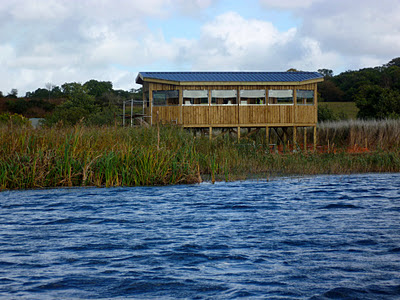Rudd (top), Roach and the new Island Mere hide. Note head shape and mouth structure of the fish.
Electro-fishing the Island Mere at Minsmere usually has to be a quick affair so as not to upset too many visitors. However, this week it was more leisurely as it is closed to visitors while a new island mere hide rises from the marsh. The hide traditionally provides excellent views of Bitterns on the edge of the mere and it was along these margins and in the adjacent ditches that we concentrated the fishing effort. The results were spectacular – an estimated fish biomass of 74 kg/ha - one of the best recorded at Minsmere. Roach formed the bulk of the biomass, but with significant increases in Rudd and Perch. Tench, 3-spined and 9-spined Sticklebacks made up the remainder of the catch.
Research has shown that Rudd are a major food source for breeding Bitterns whilst Roach are less important. Why should this be for two apparently similar fish? The answer probably has to do with differences in their behaviour. During the daylight hours of the summer months, Rudd tend to hide amongst the reedy marginal vegetation, thus making themselves easier to catch by Bitterns. By contrast, Roach spend more time out in the open water amongst weeds and away from the margins. However, in the winter months, both species move into deeper, more sheltered ditches and Roach are likely to be more available to feeding Bitterns. Given good water levels in the spring, the signs are good for breeding Bitterns next year.
Earlier in the week, on another site, I looked at the nesting site of a pair of Cranes. They can be remarkably secretive in the breeding season and tend to choose a secluded nest site surrounded by shallow water. The nest often looks out over a small clearing in the wetland where they can see the approach of predators. This particular nest clearing is growing over fast and work will be required this winter to open it up a little. However, whilst the young chicks will feed around the nest, it is the quality of the wider foraging area that will determine the likelihood and speed of the chicks fledging. Invertebrate-rich, tall vegetation, preferably in wet (squidgy) conditions is a key requirement.




No comments:
Post a Comment